Sony DVP-NS638P, DVP-NS648P User Manual
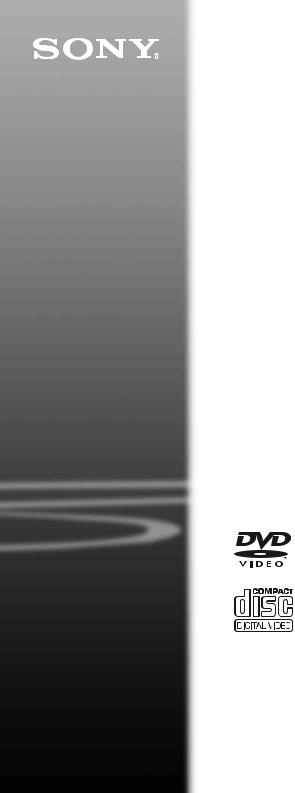
4-277-895-11(1)
CD/DVD
Player
Operating Instructions
DVP-NS638P DVP-NS648P
© 2011 Sony Corporation
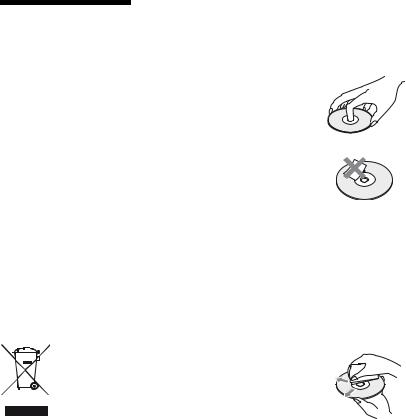
WARNING
To reduce the risk of fire or electric shock, do not expose this apparatus to rain or moisture.
To avoid electrical shock, do not open the cabinet. Refer servicing to qualified personnel only.
The mains lead must only be changed at a qualified service shop.
Batteries or batteries installed apparatus shall not be exposed to excessive heat such as sunshine, fire or the like.
CAUTION
The use of optical instruments with this product will increase eye hazard. As the laser beam used in this CD/DVD player is harmful to eyes, do not attempt to disassemble the cabinet.
Refer servicing to qualified personnel only.
Disposal of Old Electrical & Electronic Equipment
This symbol is applicable only in the European Union and other European countries with separate collection systems.
Precautions
Safety
To prevent fire or shock hazard, do not place objects filled with liquids, such as vases, on the apparatus.
Installing
•Do not install the unit in an inclined position. It is designed to be operated in a horizontal position only.
•Keep the unit and discs away from equipment with strong magnets, such as microwave ovens, or large loudspeakers.
•Do not place heavy objects on the unit.
Lightning
For added protection for this set during a lightning storm, or when it is left unattended and unused for long periods of time, unplug it from the wall outlet. This will prevent damage to the set due to lightning and power-line surges.
Notes about the discs
•To keep the disc clean, handle the disc by its edge. Do not touch the surface. Dust, fingerprints, or scratches on the disc may cause it to malfunction.
•Do not expose the disc to direct sunlight or heat sources such as hot air ducts, or leave it in a car parked in direct sunlight as the temperature may rise considerably inside the car.
•After playing, store the disc in its case.
•Clean the disc with a cleaning cloth.
Wipe the disc from the centre out.
•Do not use solvents such as benzine, thinner, commercially available cleaners, or anti-static spray intended for vinyl LPs.
•If you have printed the disc’s label, dry the label before playing.
•Do not use the following discs:
–A disc that has a non-standard shape (e.g., card, heart).
–A disc with a label or sticker on it.
–A disc that has cellophane tape or sticker adhesive on it.
2
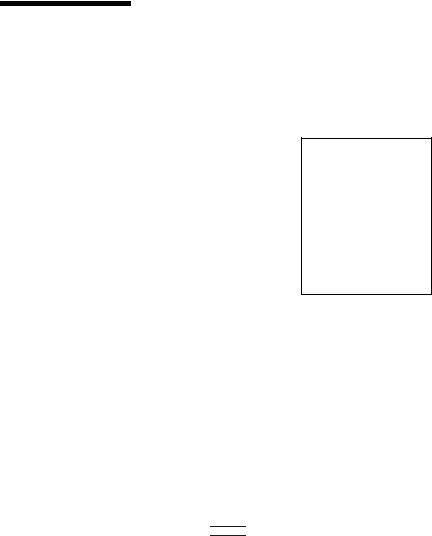
Precautions
On safety
Should any solid object or liquid fall into the cabinet, unplug the player and have it checked by qualified personnel before operating it any further.
On power sources
•The player is not disconnected from the AC power source (mains) as long as it is connected to the wall outlet, even if the player itself has been turned off.
•If you are not going to use the player for a long time, be sure to disconnect the player from the wall outlet. To disconnect the AC power cord (mains lead), grasp the plug itself; never pull the cord.
On placement
•Place the player in a location with adequate ventilation to prevent heat build-up in the player.
•Do not place the player on a soft surface such as a rug.
•Do not place the player in a location near heat sources, or in a place subject to direct sunlight, excessive dust, or mechanical shock.
•Do not install this player in a confined space, such as a bookshelf or similar unit.
•Install the player so that the AC power cord (mains lead) can be unplugged from the wall socket immediately in the event of trouble.
•If the player is brought directly from a cold to a warm location, or is placed in a very damp room, moisture may condense on the lenses inside the player. Should this occur, the player may not operate properly. In this case, remove the disc and leave the player turned on for about half an hour until the moisture evaporates.
•When you move the player, take out any discs. If you don’t, the disc may be damaged.
On adjusting volume
Do not turn up the volume while listening to a section with very low level inputs or no audio signals. If you do, the speakers may be damaged when a peak level section is played.
On cleaning
Clean the cabinet, panel, and controls with a soft cloth slightly moistened with a mild detergent solution. Do not use any type of abrasive pad, scouring powder or solvent such as alcohol or benzine.
On cleaning discs, disc/lens cleaners
Do not use cleaning discs or disc/ lens cleaners (including wet or spray types). These may cause the apparatus to malfunction.
On replacement of parts
In the event that this unit is repaired, repaired parts may be collected for reuse or recycling purposes.
Copyrights
•“DVD+RW,” “DVD-RW,” “DVD+R,” “DVD+R DL,” “DVD-R,” “DVD VIDEO,” and “CD” logos are trademarks.
•MPEG Layer-3 audio coding technology and patents licensed from Fraunhofer IIS and Thomson.
About this manual
•The instructions in this manual are for 2 models: DVP-NS638P and DVP-NS648P. Check your model name by looking at the front panel of the player. DVPNS648P is the model used for instruction purposes. Any difference in operation is clearly indicated in the text, for example, “DVP-NS648P only.”
•Icons, such as 




 , listed at the top of each explanation indicate what kind of media can be used with the function being explained.
, listed at the top of each explanation indicate what kind of media can be used with the function being explained.
For details see “Playable Media” (page 37).
•Instructions in this manual describe the controls on the remote. You can also use the controls on the player if they have the same or similar names as those on the remote.
•“DVD” may be used as a general term for commercial DVDs, DVD+RWs/DVD+Rs/DVD+R DLs (+VR mode) and DVD- RWs/DVD-Rs/DVD-R DLs (VR mode, video mode).
•NEED-to-know information (to
prevent incorrect operation) is listed under the b icon. NICE- to-know information (tips and
other useful information) is listed under the z icon.
IMPORTANT NOTICE
Caution: This player is capable of holding a still video image or on-screen display image on your television screen indefinitely. If you leave the still video image or on-screen display image displayed on your TV for an extended period of time you risk permanent damage to your television screen. Plasma display panel televisions and projection televisions are susceptible to this.
If you have any questions or problems concerning your player, please consult your nearest Sony dealer.
3

Table of Contents
WARNING . . . . . . . . . . . . . . . . . . . . . . . . . . . . . . . . . . . . . . . . . . . . . . . . . . . . 2 Precautions . . . . . . . . . . . . . . . . . . . . . . . . . . . . . . . . . . . . . . . . . . . . . . . . . . . 3 Guide to Parts and Controls. . . . . . . . . . . . . . . . . . . . . . . . . . . . . . . . . . . . . . . 6
Hookups and Settings. . . . . . . . . . . . . . . . . . . . . . . . . . . . . . . . . 10
Step 1: Connecting to Your TV . . . . . . . . . . . . . . . . . . . . . . . . . . . . . . . . . . . 10 Step 2: Connecting to Your Audio Component . . . . . . . . . . . . . . . . . . . . . . . 11 Step 3: Connecting the Mains Lead. . . . . . . . . . . . . . . . . . . . . . . . . . . . . . . . 12 Step 4: Preparing the Remote . . . . . . . . . . . . . . . . . . . . . . . . . . . . . . . . . . . . 12 Controlling TVs with the remote. . . . . . . . . . . . . . . . . . . . . . . . . . . . . . . . 13 Step 5: Quick Setup. . . . . . . . . . . . . . . . . . . . . . . . . . . . . . . . . . . . . . . . . . . . 13 Connecting a USB Device (DVP-NS648P only) . . . . . . . . . . . . . . . . . . . . . . 15
Playback . . . . . . . . . . . . . . . . . . . . . . . . . . . . . . . . . . . . . . . . . |
16 |
Playing Discs . . . . . . . . . . . . . . . . . . . . . . . . . . . . . . . . . . . . . . . . . . . . . . . . . 16 Control Menu display . . . . . . . . . . . . . . . . . . . . . . . . . . . . . . . . . . . . . . . . 18 List of Control Menu items . . . . . . . . . . . . . . . . . . . . . . . . . . . . . . . . . . . . 19 Various Play Mode Functions . . . . . . . . . . . . . . . . . . . . . . . . . . . . . . . . . . . . 21 Creating your own programme (Programme Play) . . . . . . . . . . . . . . . . . 21 Playing in random order (Shuffle Play) . . . . . . . . . . . . . . . . . . . . . . . . . . 22 Playing repeatedly (Repeat Play) . . . . . . . . . . . . . . . . . . . . . . . . . . . . . . 22 Repeating a specific portion (A-B Repeat Play). . . . . . . . . . . . . . . . . . . . 23 Customizing the Playback Configuration . . . . . . . . . . . . . . . . . . . . . . . . . . . . 24 Adjusting the playback picture (CUSTOM PICTURE MODE) . . . . . . . . . 24 Sharpening the picture (SHARPNESS) . . . . . . . . . . . . . . . . . . . . . . . . . . 24 Locking discs (PARENTAL CONTROL) . . . . . . . . . . . . . . . . . . . . . . . . . 24 Playing Video, Photo, and Music Files. . . . . . . . . . . . . . . . . . . . . . . . . . . . . . 25
Playing video, photo, and music files from USB device
(DVP-NS648P only) . . . . . . . . . . . . . . . . . . . . . . . . . . . . . . . . . . . . . . 26 Selecting a photo file . . . . . . . . . . . . . . . . . . . . . . . . . . . . . . . . . . . . . . . . 26 Setting the pace for a slide show (INTERVAL) . . . . . . . . . . . . . . . . . . . . 27 Selecting the slides’ appearance (EFFECT) . . . . . . . . . . . . . . . . . . . . . . 27
Settings and Adjustments . . . . . . . . . . . . . . . . . . . . . . . . . . . . . . 28
Using the Setup Display. . . . . . . . . . . . . . . . . . . . . . . . . . . . . . . . . . . . . . . . . 28 LANGUAGE SETUP . . . . . . . . . . . . . . . . . . . . . . . . . . . . . . . . . . . . . . . . . . . 28 SCREEN SETUP. . . . . . . . . . . . . . . . . . . . . . . . . . . . . . . . . . . . . . . . . . . . . . 29 CUSTOM SETUP . . . . . . . . . . . . . . . . . . . . . . . . . . . . . . . . . . . . . . . . . . . . . 31 AUDIO SETUP. . . . . . . . . . . . . . . . . . . . . . . . . . . . . . . . . . . . . . . . . . . . . . . . 32
Setting the digital output signal . . . . . . . . . . . . . . . . . . . . . . . . . . . . . . . . 32
4

Additional Information . . . . . . . . . . . . . . . . . . . . . . . . . . . . . . . . 34
Troubleshooting . . . . . . . . . . . . . . . . . . . . . . . . . . . . . . . . . . . . . . . . . . . . . . . 34 Self-diagnosis Function (When letters/numbers appear on the screen) . . . . 36 Playable Media . . . . . . . . . . . . . . . . . . . . . . . . . . . . . . . . . . . . . . . . . . . . . . . 37 Specifications. . . . . . . . . . . . . . . . . . . . . . . . . . . . . . . . . . . . . . . . . . . . . . . . . 39 Language Code List. . . . . . . . . . . . . . . . . . . . . . . . . . . . . . . . . . . . . . . . . . . . 40 Parental Control Area Code List . . . . . . . . . . . . . . . . . . . . . . . . . . . . . . . . . . 40 Index . . . . . . . . . . . . . . . . . . . . . . . . . . . . . . . . . . . . . . . . . . . . . . . . . . . . . . . 41
5

Guide to Parts and Controls
For more information, see the pages indicated in parentheses.
Remote
TV TV
|
PICTURE NAVI |
CLEAR |
AUDIO SUBTITLE |
TIME/TEXT |
MENU |
RETURN |
DISPLAY |
BNumber buttons
Enters the title/chapter numbers, etc.
CLEAR (19)
Clears the entry field.
CPICTURE NAVI (26)
Divides the screen into 9 subscreens so you can choose the desired scene quickly.
Each time you press the button, the display changes as follows:
•CHAPTER VIEWER
•TITLE VIEWER
•TRACK VIEWER
FAST/SLOW
PLAY
2 (volume) +, number 5, AUDIO, and N buttons have a tactile dot. Use the tactile dot as a reference when operating the player.
AZ (open/close)
Opens or closes the disc tray.
TV t(input select) (13)
Switches between TV and other input sources.
TV [/1 (on/standby) (13)
Turns on the TV, or sets to standby mode.
[/1 (on/standby) (13)
Turns on the player, or sets to standby mode.
2 (volume) +/– (13)
Adjusts the TV volume.
The photo files in the album appear in 16 subscreens.
AUDIO ( )
)
Changes the audio language or audio channel.
When 4 digits are displayed, they indicate a language code. See “Language Code List” on page 40 to see which language the code represents.
SUBTITLE ( ) (26)
) (26)
–Changes the subtitles when subtitles are recorded on DVD VIDEOs/DVD-VR mode/Xvid video files only.
–Displays lyrics for a music file when pressed during playback. For details see page 26.
6
DTIME/TEXT (9)
Displays the playing time and remaining time on the TV screen or front panel display. Press repeatedly to change the displayed information. CD/DVD text appears only when text is recorded on the disc.
If music file has an ID3 tag, the player will display the album name/track title from the ID3 tag information. This player supports ID3 versions 1.0/1.1 and 2.2/2.3.
MENU (25)
Displays the menu.
O RETURN (17)
Returns to the previous display.
DISPLAY (18)
Displays the playback information on the screen.
C/X/x/c (19)
Moves the highlight to select a displayed item.
Centre button (ENTER) (13)
Enters the selected item.
E./> (previous/next)
Skips to the previous/next chapter, track, or scene in continuous play mode.

 /
/ 
 (replay/step/step/ advance)
(replay/step/step/ advance)
–Replays the scene*1*3/briefly fast forward the scene*2*3 when pressed during playback.
–Plays backward*4/forward*5 one frame at a time when pressed during pause mode.
–Changes the LUN (Logical Unit Number) devices when pressed during the list of albums or tracks is displayed (page 26).
 m/M
m/M (scan/slow)
(scan/slow)
–Fast reverses/fast forwards when pressed during playback. The speed changes when pressed repeatedly.
–Plays backward*4/forward*5 in slow motion when pressed repeatedly during pause mode.
N (play)
Starts or re-starts playback.
X (pause)
Pauses or re-start playback.
x (stop)
Stops playback.
FAST/SLOW PLAY
Plays in various speed with sound*6 when pressed repeatedly during playback.
*1 For Xvid video files and DVDs except DVD+RWs/DVD+Rs/DVD+R DLs.
*2 For DVDs and Xvid video files only.
*3 These functions may not work with some scenes.
*4 For DVD VIDEOs and DVD-VR mode only. *5 For DVDs, VIDEO CDs, and video files only. *6 For DVDs and VIDEO CDs only.
b
Some playback functions may not work with unsupported MPEG-4 format (page 37).
,continued 7
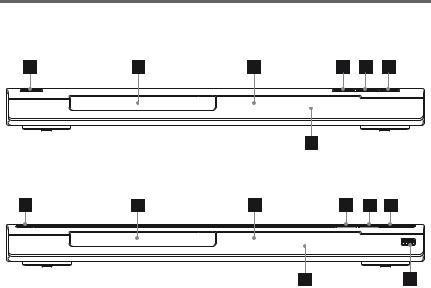
Front panel
DVP-NS638P
DVP-NS648P
A [/1 (on/standby) button (13)
B Disc tray (16)
C Front panel display (9)
D Z (open/close) button (16)
Opens or closes the disc tray.
E N (play) button (16)
The N button has a tactile dot*.
F x (stop) button (16)
Stops playback.
G  (remote sensor) (12)
(remote sensor) (12)
H  USB jack (type A) (15, 26) (DVP-NS648P only)
USB jack (type A) (15, 26) (DVP-NS648P only)
Connect a USB device to this jack.
*Use the tactile dot as a reference when operating the player.
To lock the disc tray (Child Lock)
You can lock the disc tray to prevent it being opened by mistake.
When the player is in standby mode, press O RETURN, ENTER, and then [/1 on the remote.
The player turns on and “LOCKED” appears on the front panel display. The Z button on the player does not work while the Child Lock is set.
To unlock the disc tray
When the player is in standby mode, press O RETURN, ENTER, and then [/1 again.
b
Even if you select “RESET” under “SETUP” in the Control Menu (page 28), the disc tray remains locked.
To change the colour systems
If the on-screen menu of the player does not appear on the connected TV, switch the player’s colour system to match the colour system of the TV (NTSC or PAL).
–For DVP-NS638P only
First turn off the player by pressing [/1. Next press DISPLAY, enter “0” using the number button, and then press [/1 on the remote.
–For DVP-NS648P only
First turn off the player by pressing [/1, and then press [/1 again while holding
down x on the player.
The player turns back on, and the name of the colour system will appears on the front panel display.
8
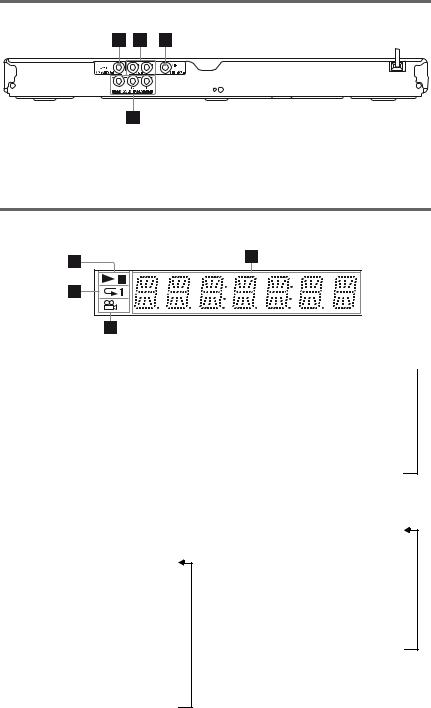
Rear panel
A DIGITAL OUT (COAXIAL) jack (11)
B LINE OUT L/R (AUDIO) jacks (11)
C LINE OUT (VIDEO) jack (10)
DCOMPONENT VIDEO OUT jacks (10)
Front panel display
AN, X
Lights up during playback or pause.
B
Lights up during Repeat Play.
C
Lights up when you can change the angle.
DPlayback information
You can view the time and text information by pressing the TIME/ TEXT button on the remote repeatedly. The display changes as follows:
When playing a DVD
Current title playing time r
Current title remaining time r
Current chapter playing time r
Current chapter remaining time
r
*1 Text r
*1 Current title and chapter number (Returns to top automatically)
When playing music or video files
Current file*2 or track*3 playing  time and number
time and number
r
*1 Current file*2 or track name/MP3 ID3 track title*3
r
*1 Current album and file*2 or track*3 number
(Returns to top automatically)
When playing a VIDEO CD (without PBC functions) or CD
Current track playing time and number
r
Current track remaining time r
Disc playing time r
Disc remaining time
r
*1 Text
*1 DVP-NS648P only *2 video file
*3 music file
9
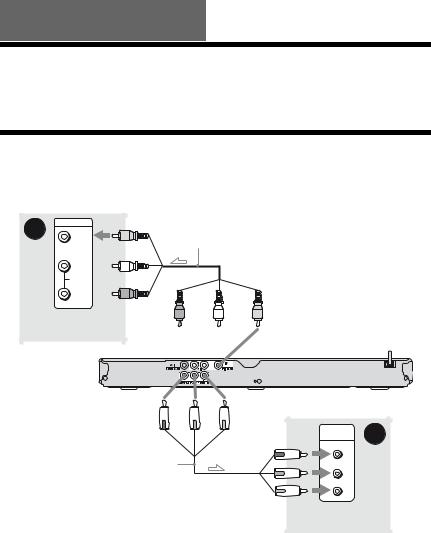
Hookups and Settings
When unpacking, check the supplied accessories by referring to page 39.
b
•Plug cables securely to prevent unwanted noise.
•Refer to the operating instructions supplied with the components to be connected.
•Be sure to disconnect the mains lead of each component before connecting.
Step 1: Connecting to Your TV
Connect this player to your TV using a video cable. Select pattern A or B, according to the input jack on your TV.
A |
INPUT |
(yellow) |
|
|
VIDEO |
Audio/video cable (supplied) |
|
||
|
|
(white) |
|
|
|
L |
|
|
|
|
AUDIO |
(red) |
|
|
|
R |
(red) (white) |
(yellow) |
|
|
TV |
|
|
|
|
|
|
to LINE OUT (VIDEO) |
|
|
to COMPONENT |
CD/DVD player |
||
|
VIDEO OUT |
(green) (blue) (red) |
|
|
|
|
|
COMPONENT |
B |
|
|
|
VIDEO IN |
|
|
|
|
|
|
|
Component video |
Y |
(green) |
|
|
|
|||
|
cable (not supplied) |
PB |
(blue) |
|
|
|
|
|
|
|
|
|
PR |
(red) |
|
|
|
|
|
l : Signal flow |
|
TV |
|
|
|
|
|
||
A Video input jack
You will enjoy standard quality images.
B Component video input jacks
(Y, PB, PR)
You will enjoy accurate colour reproduction and high quality images.
When connecting to a standard 4:3 screen TV
Some images may not fit your TV screen. To change the picture size, see page 29.
b
Do not connect a VCR, etc., between your TV and the player. If you pass the player signals via the VCR, you may not receive a clear image on the TV screen. If your TV has only one audio/video input jack, connect the player to this jack.
10
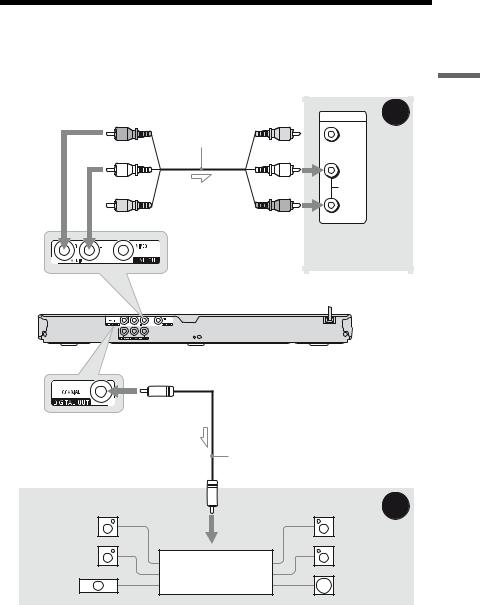
Step 2: Connecting to Your Audio Component
Select one of the following patterns A or B, according to the input jack on your TV monitor, projector, or audio component such as an AV amplifier (receiver).
This will enable you to listen to sound.
(red) |
(yellow)* |
INPUT |
A |
|
Audio/video |
VIDEO |
|
|
cable (supplied) |
|
|
|
|
|
|
(white) |
(white) |
|
|
|
|
L |
|
(yellow)* |
(red) |
AUDIO |
|
|
|
R |
|
TV, projector, or audio component
to LINE OUT L/R (AUDIO)
Settings and Hookups
to DIGITAL OUT |
CD/DVD player |
(COAXIAL) |
|
|
Coaxial digital cable |
|
|
|
(not supplied) |
|
|
|
to coaxial |
[Speakers] |
B |
[Speakers] |
digital input |
||
Rear (L) |
|
Rear (R) |
|
Front (L) |
|
Front (R) |
|
|
Audio component |
|
|
Centre |
with a decoder |
Subwoofer |
|
|
|
 : Signal flow
: Signal flow
* The yellow plug is used for video signals (page 10).
z
For correct speaker location, see the operating instructions supplied with the connected components.
,continued 11
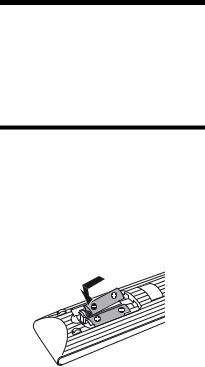
A Audio L/R input jacks
This connection will use your TV’s or audio component’s two speakers for sound.
B Digital audio input jack
If your audio component has a Dolby* Digital, DTS, or MPEG audio decoder and a digital input jack, use this connection. You can enjoy Dolby Digital (5.1ch), DTS (5.1ch), and MPEG audio (5.1ch) surround effect.
*Manufactured under license from Dolby Laboratories.
Dolby, Pro Logic, and the double-D symbol are trademarks of Dolby Laboratories.
b
•After you have completed the connection, make the appropriate settings in Quick Setup (page 13). If your audio component has an MPEG audio decoder function, set “MPEG” to “MPEG” in “AUDIO SETUP” (page 33). Otherwise, no sound or a loud noise will come from your speakers.
•In order to listen to DTS sound tracks, you must use this connection. DTS sound tracks are not output through the LINE OUT L/R (AUDIO) jacks, even if you set “DTS” to “ON” in Quick Setup (page 13).
Step 3: Connecting the
Mains Lead
Plug the player and TV mains lead (power cord) into a mains.
Step 4: Preparing the
Remote
Insert two R6 (size AA) batteries by matching the 3 and # ends on the batteries to the markings inside the compartment. When using the remote, point it at the remote sensor  on the player.
on the player.
b
•Do not leave the remote in an extremely hot or humid place.
•Do not drop any foreign object into the remote casing, particularly when replacing the batteries.
•Do not expose the remote sensor to direct light from the sun or a lighting apparatus. Doing so may cause a malfunction.
•If you do not use the remote for an extended period of time, remove the batteries to avoid possible damage from battery leakage and corrosion.
12
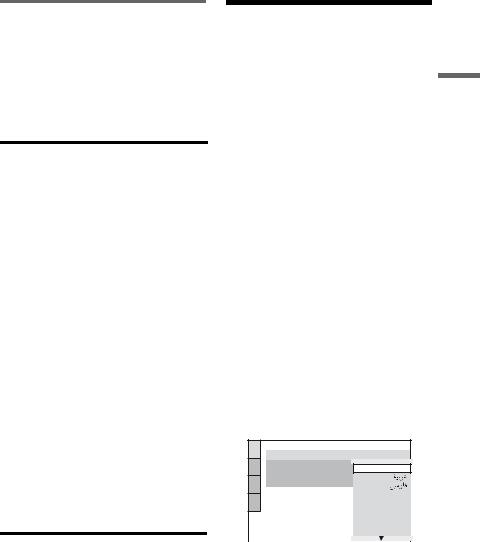
Controlling TVs with the remote
You can control the sound level, input source, and power switch of your Sony TV with the supplied remote.
Available buttons
Depending on the connected unit, you may not be able to control your TV using all or some of the buttons on the supplied remote.
Buttons |
Operations |
TV [/1 |
Turn the TV on or off |
|
|
2 (volume) |
Adjust the volume of the |
+/– |
TV |
|
|
TV t |
Switch the TV’s input |
(input select) |
source between the TV and |
|
other input sources |
|
|
To control other TVs with the remote
You can control the volume, input source, and power switch of non-Sony TVs as well.
If your TV is listed in the table below, set the appropriate manufacturer’s code.
b
When you replace the batteries of the remote, the code number may be reset to the default setting. Set the appropriate code number again.
1While holding down TV [/1, press the number buttons to select your TV’s manufacturer’s code.
2Release TV [/1.
Code numbers of controllable TVs
If more than one code number is listed, try entering them one at a time until you find the one that works with your TV.
Manufacturer |
Code number |
Sony |
01 (default) |
|
|
Hitachi |
24 |
|
|
JVC |
33 |
|
|
LG/Goldstar |
76 |
|
|
Panasonic |
17, 49 |
|
|
Philips |
06, 08, 72 |
|
|
Samsung |
71 |
|
|
Sharp |
29 |
|
|
Toshiba |
38 |
|
|
Step 5: Quick Setup
Follow the steps below to make the minimum number of basic adjustments for using the player.
To skip an adjustment, press >. To return to the previous adjustment, press .. The on-screen displays differ depending on the player model.
1 Turn on the TV then press [/1.
2 Switch the input selector on your TV so that the signal from the player appears on your TV screen.
“Press [ENTER] to run QUICK SETUP” (press enter to run Quick Setup) appears at the bottom of the screen. If this message does not appear, select “QUICK” (quick) under “SETUP” (setup) in the Control Menu to run Quick Setup (page 19).
3 Press ENTER without inserting a disc.
The Language Setup Display appears. The available languages differ depending upon the player model.
LANGUAGE SETUP
OSD: ENGLISH
MENU:
AUDIO: ENGLISH
SUBTITLE:
FRANÇAIS
DEUTSCH
ITALIANO
ESPAÑOL
NEDERLANDS
4 Press X/x to select a language.
The player displays the menu and subtitles in the selected language.
5 Press ENTER.
The Screen Setup Display appears.
Settings and Hookups
,continued 13
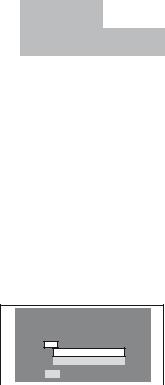
|
SCREEN SETUP |
|
|
|
|
TV TYPE: |
16:9 |
|
|
COLOR SYSTEM (VIDEO CD): |
16:9 |
|
|
SCREEN SAVER: |
4:3 LETTER BOX |
|
|
BACKGROUND: |
4:3 PAN SCAN |
|
|
PROGRESSIVE (COMPONENT OUT ONLY): OFF |
|
|
|
MODE (PROGRESSIVE): |
AUTO |
|
|
4:3 OUTPUT: |
FULL |
|
|
|
|
6 Press X/x to select the setting that matches your TV type.
If you have a wide-screen TV or a 4:3 standard TV with a wide-screen mode
• 16:9 (page 29)
If you have a 4:3 standard TV
•4:3 LETTER BOX or 4:3 PAN SCAN (page 29)
7 Press ENTER.
The Setup Display for selecting the type of jack used to connect your audio component appears.
Is this player connected to an amplifier (receiver) ? Select the type of jack you are using.
YES
LINE OUTPUT L/R (AUDIO)
DIGITAL OUTPUT
NO
8 Press X/x to select the type of jack
(if any) you are using to connect to an audio component, then press ENTER.
Select “NO,” if you do not connect an audio component, then go to step 12. Select “YES: LINE OUTPUT L/R (AUDIO),” if you connect an audio component using an audio cable, then go to step 12.
Select “YES: DIGITAL OUTPUT,” if you connect an audio component using a digital coaxial cable.
9 Press X/x to select the type of
Dolby Digital signal to your audio component.
If your audio component has a Dolby Digital decoder, select “DOLBY DIGITAL.” Otherwise, select “D-PCM.”
|
AUDIO SETUP |
|
|
|
|
|
AUDIO DRC: |
|
STANDARD |
|
|
DOWNMIX: |
DOLBY SURROUND |
|
|
|
DIGITAL OUT: |
|
ON |
|
|
|
||
|
|
DOLBY DIGITAL: |
|
DOLBY DIGITAL |
|
|
MPEG: |
|
DOLBY DIGITAL |
|
|
DTS: |
|
D-PCM |
|
|
48kHz/96kHz PCM: |
48kHz/16bit |
|
|
|
|
|
|
10Press ENTER.
“DTS” is selected. |
|
|
|
|||
|
|
|
|
|
|
|
|
|
AUDIO SETUP |
|
|
|
|
|
|
|
AUDIO DRC: |
|
STANDARD |
|
|
|
|
DOWNMIX: |
DOLBY SURROUND |
||
|
|
|
DIGITAL OUT: |
|
|
ON |
|
|
|
DOLBY DIGITAL: |
|
DOLBY DIGITAL |
|
|
|
|
MPEG: |
|
|
PCM |
|
|
|
DTS: |
|
|
OFF |
|
|
|
48kHz/96kHz PCM: |
|
OFF |
|
|
|
|
||||
|
|
|
|
|
|
ON |
|
|
|
|
|
|
|
11Press X/x to select whether or not to send a DTS signal to your audio component.
If your audio component has a DTS decoder, select “ON.” Otherwise, select “OFF.”
12Press ENTER.
Quick Setup is finished and connections are complete.
If your audio component has an MPEG audio decoder, set “MPEG” to “MPEG” (page 33).
14
